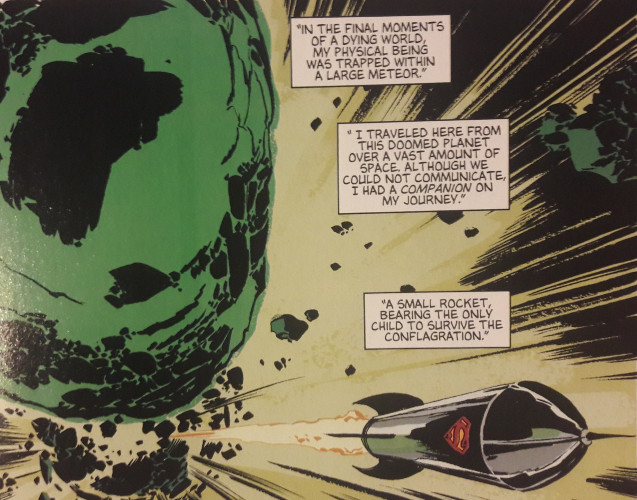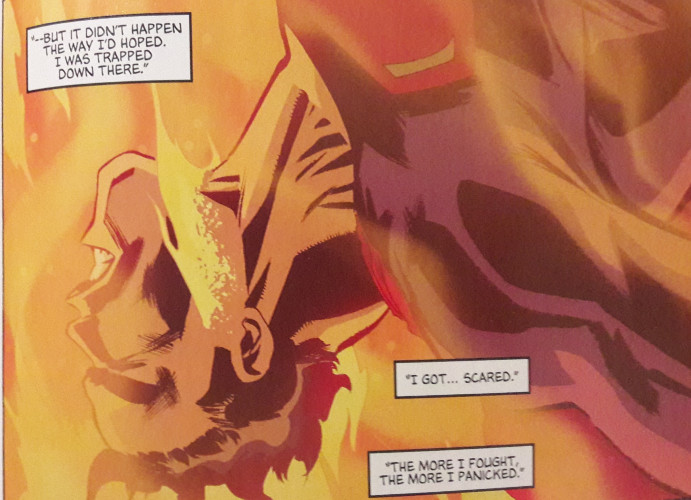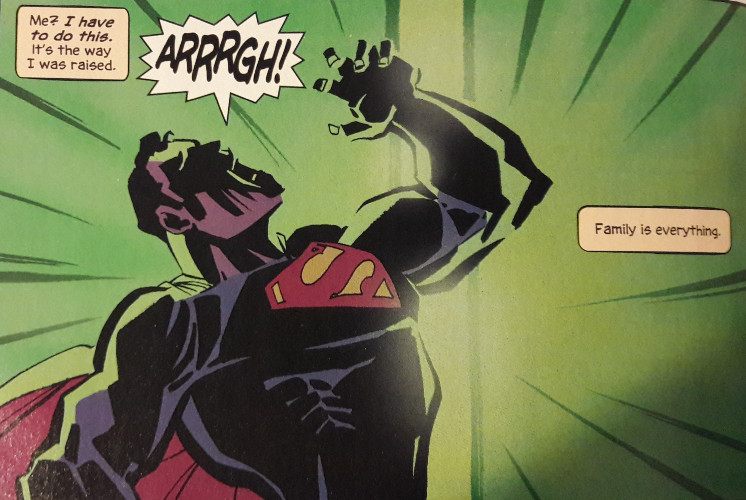Distinguished Critique: Superman: Kryptonite Review
This arc provides an entertaining look at a younger Superman's encounter with his famed weakness, even if all the included elements feel jumbled
—by Nathan on October 19, 2023—

A bullet hits the Man of Steel in the chest, the sudden impact causing the projectile to crumple in on itself and clatter to the ground with a small tink-tink-tink. It’s now as flat as a quarter...and about as harmless. Whatever goon, bank robber, or terrorist unlikely enough to try and stop Superman with a gun only has a few seconds to regret his decision before the hero snatches his weapon away or melts it into metal mush.
Metropolis’ favorite son has long been immune to the ordinance he’s also faster than. Bullets bounce and rockets rebound…in Frank Miller’s The Dark Knight Returns, Supes even shrugged off an atomic bomb. And though the intervening decades between his first appearance and modern interpretations have seen his invulnerability fluctuate, one massive weakness has primarily marched right alongside the years: kryptonite, fragments of Krypton, Superman’s home planet, expelled to Earth when the planet exploded. They weaken and hurt the Man of Steel, becoming an integral part of Superman’s mythos and a consistent thorn in his side.
The late Darwyn Cooke and the late Tim Sale develop their own twist on the deadly green mineral in a six-issue arc in Superman Confidential. Taking place during Superman’s early years and drawing inspiration from 1949’s Superman #61, Cooke and Sale update Supes’ first encounter with kryptonite and how the hero comes to understand that maybe he’s not as invulnerable as he believes himself to be.
Superman: Kryptonite
Writer: Darwyn Cooke
Penciler: Tim Sale
Inker: Tim Sale
Colorist: Dave Stewart
Letterers: Richard Starkings, Jared K. Fletcher
Issues: Superman Confidential #1-5, #11
Publication Dates: January-April 2007, June 2007, March 2008

Note: save for some minor edits, this blog is the same as it was when I originally posted it to Hubpages
Cooke and Sale were, obviously, not the first creators to use kryptonite prominently in the 21st Century. Mark Waid and Geoff Johns utilized the mineral as a weakness in Superman: Birthright and Superman: Secret Origin, respectively. Both writers detailed their version of Superman’s first encounter with the rock, early in his career, and the damaging effects it could cause. But Cooke and Sale are more interested in the concept of weakness.
Specifically, Cooke crafts the idea that his Superman is still exploring his limits. When a tanker of liquid nitrogen explodes, the Man of Steel is completely frozen, wondering if the experience will kill him. It doesn’t. When he enters an erupting volcano, he questions whether the lava can damage his organs if he inhales it. He’s fine. But each new experience, each new danger, each new threat offers uncertainty to Clark.

It’s a very refreshing way to examine Superman. We’re thrown backwards in time, to Superman’s early adventures. With Tim Sale as penciler, the narrative feels like a spiritual sequel to Superman For All Seasons–Clark’s a young hero, fresh and new on the Metropolitan scene, uncertain of his weaknesses. This is a Superman who makes mistakes, questions himself, and approaches each new situation cautiously. He feels, in a sense, more heroic here; while fans may understand his invulnerability, Clark isn’t completely aware and thus faces new dangers which, as far as he knows, may end up harming or killing him. He doesn’t have the security that everything is gonna slough off his nigh invincible form.
The introduction of kryptonite feels like both the natural extension of that idea and a somewhat coincidental plot development. The "coincidental" element stems from Cooke’s dialogue, which often doubles down on the "Is Superman invincible?" concept. During a battle with the Royal Flush Gang, Clark muses on his invulnerability; he discusses the idea with Ma and Pa Kent after the volcano ordeal, seeking their guidance. Pictorially, Tim Sale does more than enough in both instances to showcase Clark’s concern, meaning I would have appreciated it if Cooke had spent a little less time discussing Superman’s limits.

While I understand the importance of seeding thematic elements throughout a narrative, I also believe in a more "Show, don’t tell" method of storytelling. Sale properly conveys Clark’s concern and worry without Cooke telegraphing the concept repeatedly. And I know those early incidents are intended to tether to later issues where Supes interacts with kryptonite for the first time, finding himself in a situation where he can be hurt or affected by a weapon. Still, I would have rather made the connection myself instead of having Cooke make it plain.
Other story beats also fall as awkwardly as a flaming chunk of green meteor to the ground. Lois Lane comes off a tad cold towards Superman after the hero misses one too many romantic outings, concluding she and Superman aren’t meant to be. Again, I understand Cooke’s attempting to create tension by having Lois consider Superman’s importance to the world and the struggle she experiences by knowing she can’t be completely "his." Lois, unfortunately, deals with the matter too nonchalantly. If any meaning can be found here, Cooke fortunately uses the "break up" to have Clark consider his frailties beyond his physical vulnerabilities. Lois’ rejection of him probably stings as much, if not more, than exposure to kryptonite. He can shrug off liquid nitrogen, but a cold shoulder from the girl he likes is a little harder to recover from.

Elsewhere, Cooke oddly ropes the Kents into the mix. Much like other writers’ treatment of them, Ma and Pa Kent stand as Clark’s staunch defenders and comforters, willing to lend a listening ear and a wise voice whenever needed. Yet Cooke decides to shoehorn some unnecessary Pa/Ma Kent conflict, as Pa wishes Clark to be sensitive towards his mother regarding his superhero-ing. This subplot pops up only once more, with Ma Kent basically admonishing Pa (she’s made of stern stuff, dang it) and with the whole episode vaguely introduced and tidily wrapped up later.
I think I would have appreciated both of these subplots more if Cooke had discovered a way to make them more integral to the overall narrative. Could we have gotten more of the Lois/Superman conflict, with Clark focusing on his internal weaknesses as much as external vulnerabilities? Could the Pa/Ma Kent conflict have been a way of showing what characteristics Clark has gleaned from his adoptive parents over the years? Deeper points linger thinly through each subplot, never flourishing or feeling whole.

The larger plot, though somewhat basic, feels more thorough. Cooke personifies kryptonite, making a chunk of it sentient and allowing its own journey to and across the Earth to parallel Clark’s own Earth-bound odyssey. The plot device feels a little awkward at first, but once Cooke makes the tether to Clark, pieces start falling into place. Unlike his usage of his human supporting cast members, Cooke lets the reader inform themselves of the connections between Superman and this hunk of rock so commonly used towards his downfall.
The plot works well through the series, with Cooke creating a somewhat slow-burn between the kryptonite plot and a few other human characters, including Lex Luthor. Here and there, Cooke reveals that smaller scenes play larger roles as the story develops and ensures readers, by the end, that any early awkwardness is wrapped up or questions they may have are answered. Nothing too mind-boggling occurs, but the series gracefully reaches its end with the plot fully formed and settled. It’s just those bits between the bones of his narrative which Cooke can’t quite fill with satisfying marrow.

Tim Sale expresses his diverse talent here, and I was especially intrigued by his Superman design. In several places in For All Seasons, I felt as if Sale’s Superman was too broad, his farmboy Clark Kent often coming across as lumbering and oafish. His Superman here feels a tad svelter, still muscular but less exaggerated; his Clark Kent wears suits and a bathrobe, feeling more at home in Metropolis. Again, commenting on the "spiritual successor to For All Seasons' vibe, we’re offered a Clark Kent who has gained some familiarity with Metropolis; he seems more comfortable with his surroundings and job. The environment is less–dare I say it?–alien to the boy from Smallville.
Sale’s best images throughout the series can be isolated, almost removed from the story as a whole, set apart as well-illustrated snapshots. A single panel sees Superman in the frozen wastes, having befriended a polar bear. Clark stands in the doorway to the Kents’ kitchen after stopping the volcano, his suit burnt and patchy, his expression like that of a forlorn kid fessing up to breaking a lamp or vase. A bruised Superman, beaten by armored thugs after being weakened by kryptonite, gets his second wind, a smile curling even as his fist curls, ready to subject his foes to his full might. Tiny, wonderfully artistic moments like these deliver a less-grounded, more fantastical adventure than For All Seasons, showcasing Sale’s variety in depicting the Man of Steel.

Is this "Kryptonite" tale one of my favorite Superman stories? No, probably not, especially when ranked alongside stories like Birthright, Red Son, American Alien, and Secret Identity. Its theming is definitely engaging, even if Cooke can’t quite finagle all the pieces together. He tackles Superman from a unique angle–young, stutter-stepping his way through his newfound superhero career, unaware of his full abilities. When Cooke allows Sale more control over the narrative’s artistic lens, that theme is powerful. The image of Clark, standing in the Kent’s kitchen, his suit burnt, his cape tattered, his eyes uncertain and tinted with fear, speaks more than any dialogue Cooke can write. Unfortunately, Cooke also tries packing in a variety of other elements–Lex Luthor, Clark’s relationships with Lois and his parents, the Royal Flush Gang, Clark Kent clones, a second smarmy villain, and a sentient hunk of kryptonite–and all these diverse pieces fail to come together, splintering like Krypton before its imminent demise.